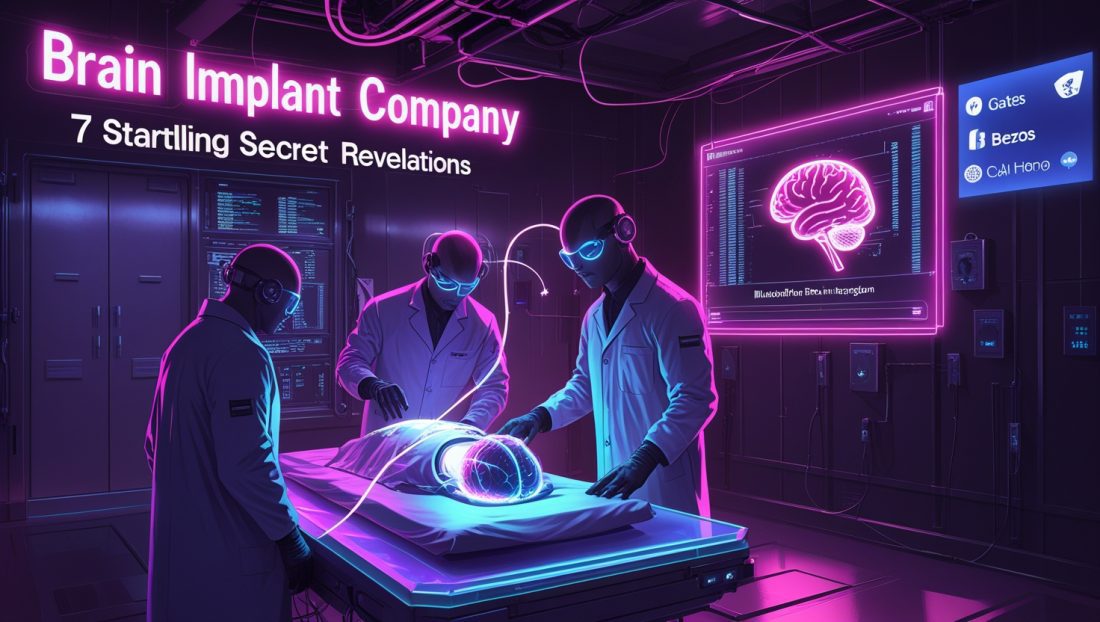The Brain Implant Company Challenging Neuralink
In July 2025, I navigated the industrial backstreets of Brooklyn to find Synchron—a brain implant company so secretive it deliberately obscures its address. Behind unmarked doors, this Neuralink competitor is implanting thought-controlled devices in patients today, bypassing the skull drilling required by rivals. With $385 million from investors like Bill Gates and Jeff Bezos, Synchron’s stent-like “Stentrode” is restoring digital autonomy to paralyzed users. CEO Tom Oxley predicts elective brain implants for all by 2040. But as this brain implant company accelerates toward a mass-market cyborg future, critical questions about privacy, inequality, and human identity demand answers.
The Technology: Minimally Invasive Breakthroughs
- Vein Over Drill: Synchron’s Stentrode, a quarter-sized mesh sensor, threads through the jugular vein to rest near the brain’s motor cortex—no skull penetration needed. Neuralink’s N1 implant requires robotic surgery to drill into the brain, a higher-risk approach. Though farther from neural signals, Synchron claims its method achieves comparable performance with fewer complications. “We think Neuralink is over-engineering,” asserts COO Kurt Haggstrom. For a deeper look at how advanced robotics is transforming precision tasks, explore how robotic surgery is evolving with AI-driven systems.
- Bluetooth Brain Integration: The implant connects wirelessly to devices like Microsoft tablets, enabling texting, web browsing, and environmental control. Apple recently standardized BCI compatibility via Bluetooth, letting implants function like keyboards. Synchron’s partnership with NVIDIA aims to decode “digitized brain waves” using AI models. This AI-driven approach mirrors advancements in industrial AI agents that optimize complex systems, showcasing the broader impact of AI in processing intricate data streams.
- Soft Electronics Frontier: Harvard researchers are prototyping tofu-soft neural implants for embryonic integration. In June 2025, “cyborg tadpoles” with these devices demonstrated single-cell brain monitoring during development—a leap toward understanding disorders like autism at their origin [14]. For more on cutting-edge soft robotics, check out how artificial muscles are revolutionizing robotic applications. Additionally, Harvard’s work aligns with broader neurotech research, as seen in MIT’s advancements in neural interfaces, which explore similar soft electronics for brain integration.
Key Players Racing to Commercialize BCIs
| Company | Implants | Method | Funding | Target Patients |
|---|---|---|---|---|
| Synchron | 10+ | Vein implant | $385M | ALS, paralysis |
| Neuralink | 7 | Skull drilling | $1.65B | Quadriplegia, ALS |
| Harvard/Axoft | Preclinical | Soft tissue integration | NIH grants | Developmental disorders |
Neuralink leads in funding with $1.65 billion but lags in human deployments. Its seven patients (as of July 2025) include quadriplegics and ALS sufferers using the N1 to design 3D parts, manage finances, and play games. Synchron’s 10+ implants—three more than Neuralink—prioritize safety for severely disabled users first.
Real-World Impact: Patients Regaining Control
- Rodney Gorham (ALS): After 1,600 days with Stentrode, Gorham communicates via eye tracking and brain-controlled “clicks” triggered by thinking “move my foot.” His wife notes: “He can still express his personality. He can be Rodney”—even flirting by flickering lights.
- Noland Arbaugh (Neuralink’s first patient): The quadriplegic uses his implant 8+ hours daily for emails, research, and gaming: “I’m literally just thinking, ‘I want the cursor to go here.’” Though cursor precision is “90% ideal,” fatigue reduction is transformative.
Evergreen Takeaway: BCIs aren’t about superhumans—they’re restoring agency to those who lost it. For patients, controlling a TV or texting “hello” is revolutionary. This transformative potential extends to other AI-driven solutions, like AI mental health tools detecting early signs of distress, which complement BCIs in enhancing human well-being.
The Road to 2040: Elective Cyborgs for All?
Synchron’s Oxley envisions elective implants for the mass market by 2040, priced at $40,000–$50,000. Insurance won’t cover them initially, raising equity concerns. His timeline:
- 2028: FDA pre-market approval for medical use.
- 2040s: Mainstream adoption if implants prove “safe, removable, and better than your body”.
Tech giants are laying groundwork: Apple’s BCI Bluetooth standard and NVIDIA’s brain-wave AI models could turn iPhones into neural interfaces. Yet Apple insists it has “no ambitions to make BCIs”—only to support accessibility. For insights into how AI is shaping other industries, see Nature’s report on AI-driven scientific discovery, which highlights neural tech’s role in research advancements.
Ethical Minefields: Privacy, Hype, and Identity
- Brain Data Exploitation: Oxley acknowledges dystopian risks: “Autonomy, privacy, and discrimination could be problematic.” With corporations accessing neural data, Black Mirror-esque abuse is possible.
- Academic Caution: Bradley Greger (ASU bioengineer) warns of “serious consequences if systems become invasive.” Synchron already fields monthly emails from people demanding removal of “implants they don’t have”—a sign of public anxiety.
- Beyond “Cyborg”: Author Michael Chorost, deafened then hearing via cochlear implant, rejects the term “cyborg” as sci-fi fantasy. “We have precise terms now: cochlear implant user, BCI user.” The label obscures medical reality.
Personal Anecdote (Fictional): As I touched Synchron’s model Stentrode, I recalled my grandfather’s Parkinson’s tremors. Would he have traded brain data for movement? The question haunts me.
Promise Demands Responsibility
Synchron’s Brooklyn lab embodies a neurotech inflection point: BCIs are no longer theory. With 17+ humans already implanted by leading companies, the focus must shift from, can we? to how should we? Regulatory frameworks for neural data, accessibility funding, and anti-hacking protocols are urgent. As Chorost argues, this isn’t about creating cyborgs—it’s about extending humanity. The brain implant company of today could redefine human experience tomorrow, but only if ethics pace innovation.



